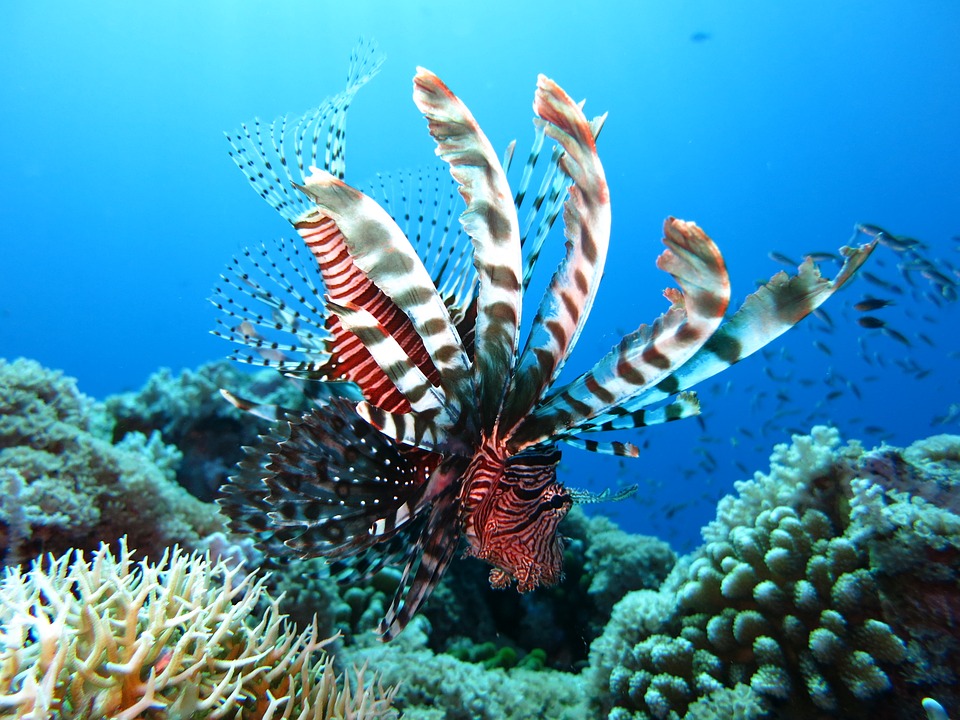Coral reefs first appeared 485 million years ago, and are often known as "rainforests of the sea". Coral reefs are formed by reef building corals in colonies of coral polyps by calcium carbonate and they constitute an important underwater ecosystem. Reefs grow well in warm, shallow, clear, sunny water. Shallow water coral reefs form the most important diverse ecosystems on the earth but deep water and cold water coral reefs exist on smaller scales in other areas. Coral reefs deliver ecosystem services for fisheries and shoreline protection.
Coral reefs are sensitive to water conditions. More than 60% of the world’s coral reefs are under immediate and direct threat from human activities such as over fishing. The major coral reef areas in India are Gulf of Kutch, Gulf of Mannar, Lakshadweep and Andaman and Nicobar Island with an outspread area of 5,790 square kilometres. The world's largest coral reef is the Great Barrier Reef and constitutes about 2,900 individual reefs and spread over 900 islands with an area of approximately 344,400 square kilometres.
Coral reefs contribution to Fisheries.
Coral reefs occupy an area less than 0.1% when compared to the world's ocean area but they provide home for at least 25% of all marine species, including molluscs, worms, crustaceans, echinoderms, sponges and more than 4000 species of fishes. Healthy reefs can produce up to 35 tons of fish per square kilometer annually. They provide home and nursery grounds to numerous fish species. They provide food to the juveniles and shelter them from predators.
Climate change and its threats to Coral reefs.
Climate change is the most important global threat to coral reef ecosystems. Climate change will pave way to the destruction of the coral reef ecosystems, through sea level rise, Ocean acidification, frequency and intensity of tropical storms, and altered ocean circulation patterns. When combined, the impacts will reduce the reef productivity and thus affecting the reef dependent fish populations. The threats to coral reef can adversely affect the livelihoods of fishers and coastal communities.
Mangroves and its contribution to Fisheries
A mangrove is a shrub or small tree that mostly grows in coastal or brackish water. The world area of mangroves forests accounted in 2000 was about 137,800 square kilometres spanning across 118 countries and territories. The fisheries potential in mangroves forest is most productive and biodiversity providing significant functions in the coastal zones. Mangroves serve as a critical nursery for young marine life and play an important role in the health of fisheries. In India there are about 105 species of fishes, 20 species of shellfishes and more than 225 species of crustaceans that depend on mangrove ecosystems and account for about 60% of India's coastal marine fish species.
The most common fishes found in Indian mangrove waters are Liza, Mugil, Lates, Polynemus, Sciaena, Setipinna, Pangasium, Hilsa, Ilisha and Etroplus. Shrimp species of Penaeus and Metapenaeus and the crabs are represented by Scylla serrata. The molluscans of mangrove waters are represented by Crassostrea spp., Mytilus and clams. In the upstream regions, giant prawns like Macrobrachium rosenbergii will be found in large quantities.
The mangrove forest in Pichavaram at Tamil Nadu is one of the largest mangrove forests in India and the Bhitarkanika Mangroves Forest of Odisha, is the second largest mangrove forest of India. Majority of mangals are found on the Andaman and Nicobar Islands and at the Gulf of Kutch in Gujarat. Indian mangrove forests consist of 46 species and 4 of which are natural hybrids, belonging to 22 genera and 14 families, representing about 57% of the world's mangrove species.
Healthy mangroves an alternate to coral Reef Fisheries production
A study from the University of Queensland found that healthy mangroves on the coastal areas may help in fighting the consequences of climate change on coral reef fisheries production and also providing support for sea life. Scientists are worried that the declining of the coral reefs due to climate change and human impacts on it may decline the yield of production of fisheries to half of the current production rate.
Many people are worried about the loss of coral reefs, the concern is that the reef protects the fish juveniles from predators and if reefs are lost, the hiding places and nursery ground for the thousands of fish species are being lost and that becomes easy open ground to the predators. Even the juveniles of predators also experience similar problems at their young stage so the entire food chain and food web becomes unproductive and only a few species of fish juveniles can survive.
Mangroves support the marine nurseries productivity equal to that of the reefs nursery if reefs are lacking in that particular area. Despite of alarming trend a healthy mangrove forest may be an alternate nursery habitat. Researchers have found that many species of marine fish can use the mangroves as an alternate nursery habitat. Infact the nursery provided by mangroves can support the challenges faced by the degradation of coral reef at the early stages.
Conclusion
Mangrove restoration is important at this stage to support fisheries and this should remain as the priority. The effort to prevent degradation of coral reef is also important until then the mangrove forests act as a buffer to fisheries production. At this juncture both priorities should be given to battle the mitigation of global climate change and its impacts on the coral reefs. Ultimately we should protect both the mangroves and coral reef ecosystem to maintain marine fisheries production at sustainable rate.
